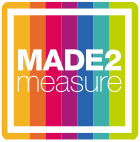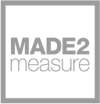How To Measure And Check A Wall For Mirrors
Step 1 - what you need
You will need a tape measure, spirit level, pencil and paper. If you are measuring angles and you do have access to a laser measure or angle calculator this would make such measurements easier but are not essential.
Step 2 - Check your access points
On occasion customers have purchased a very large bespoke mirror and not considered that they cannot get the mirror either up the stairs or into the room itself that the mirror wants to be hung in. Before you purchase check and consider where and how the mirror will be moved into the room it is being installed in. Consider this as you may have to break your mirror requirements into smaller panels to accommodate this.
Please note we do not deliver up stairs due to our insurance limitations and will only deliver safely to nearest storage point at your access entrance point.
Step 3 - Consider how complicated you need it to be
A lot of people may think it is rather easy just to measure a small or large space but beware as there can be lots of hidden hazards that are not always seen with the naked eye. The most common problem that occurs is that the space you require your mirror to fit is not perfectly square. Failure to identify an area being longer even just by a few mm on one side, this is known as a "rake", can cause disappointment when you try to fit your mirrors.
As a result ask yourself the question - how complicated do I want this to be?
For example for gym and dance mirror applications we suggest trying to avoid going ceiling to floor and / or wall to wall but rather leave a minimum 100mm border all the way around except perhaps floor level if placing close to the skirting board. This removes all the complication from your measuring process. In our experience no wall or floor is perfectly straight but it is to the eye. However if you put a straight mirror next to wall that slopes 4-5mm you will see it clearly and it will annoy you. Place the mirrors 100mm away from the wall and the eyes will not pick up these discrepancies.
Areas that are not totally filled with mirror obviously allow for more margin of error when measuring and as such should be straight forward.
Obviously for many applications this does not apply and exact measurements are required.
Step 4 - Check your walls
Check your walls for bowing - either inwards or outwards. This can be easily done by placing your spirit level onto the wall and moving it across the area to check if the spirit level stays flat to wall or not. If the wall has an inward bow to it this is OK but you need to select 5mm or 6mm thickness if gluing as 4mm mirror may flex and cause distortion or select 4mm thickness with safety backing and screw holes. If however the wall has a bow bulging outwards you will need to do some remedial work such as replaster the wall. The mirrors cannot bend and therefore in such instances one end of the mirror will never be attached to the wall and therefore cannot be hung safely.
Next you need to check the integrity and stength of your walls. Some new build house have very thin walls and may not be able to accommodate 6mm thickness mirror - the weight for 6mm is 15kgs per m2 - or be suitable for use with holes and screws as the mirrors would need to find the studwork and this may not be feasible.
For some of our large framed mirrors you also need to check your wall is suitable and strong enough to hang them on as they can weigh 50kgs or more dependent on size. The weight of your products are displayed during the buying process.
Walls which are porous cannot be fixed or installed with glue - for example concrete block and bare brick - so again take time to identify your wall type and strength to help determine your specifications.
If unsure seek the advise of a local builder/ tradesman / professional.
Step 5 - Take your measurements
Step 6 - Measure again!
Measure three times - manufacture once!





